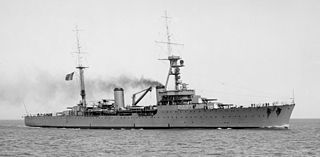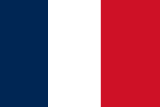Twelve vessels of the French Navy have been named Duguay-Trouin in honour of René Duguay-Trouin.

Primauguet was a French Duguay-Trouin-class light cruiser built after World War I. During the Anglo-American invasion of French North Africa in 1942, she was burnt out and abandoned, having been subject to gunfire from a fleet led by the battleship Massachusetts, and repeated aerial attacks by SBD Dauntless dive bombers. She was named after the 15th century Breton captain Hervé de Portzmoguer, nicknamed "Primauguet".

Algérie was the last treaty cruiser constructed for the French Navy. Designed and built in response to the Italian's Zara class of 8-inch gun cruisers, she was a totally new design and not based on the previous ships. The armoured caisson system used in Foch and Dupleix was abandoned in favour of a full armoured belt enclosing both the magazines and machinery spaces. She abandoned the unit propulsion system used previously and grouped her boilers forward leading to the reduction to a single funnel. She was one of the first vessels to utilize super heating boilers. Welding was used primarily in place of the normal rivetting in previous vessels. She maintained the same main armament but her secondary guns were increased to 100 mm guns. She served in the Mediterranean Sea after entering service then searched for German surface raiders at the beginning of the war. She was at Toulon, France, at the time of the Armistice and remained there until scuttled in November 1942.

The Duguay-Trouin-class were the first major French warships built after World War I. They were excellent steamers and proved successful and seaworthy over a quarter century of service. All three achieved 33 knots on trials and could easily maintain 30 knots in service. Twenty-year-old Duguay-Trouin could still maintain 27.7 knots at her post-war displacement of 10,900 tons. They were fast and economical, although with a limited range. The fate of these three ships after the French surrender illustrates the dichotomy within the French armed forces at the time: one ship was interned, then joined the Free French, another twice resisted Allied bombardment and was destroyed, and the third was disarmed at a French colonial port and subsequently sunk.

The La Galissonnière-class cruisers were commissioned by the French Navy in the 1930s. They were the last French cruisers completed after 1935, until the completion of De Grasse in 1956. They are considered fast, reliable and successful light cruisers. Two cruisers of this class, Georges Leygues and Montcalm, took part in the defence of Dakar in late September 1940 during World War II. With the cruiser Gloire, they joined the Allied forces after the successful Allied landings in North Africa in November 1942. The three other cruisers of the La Galissonière class, held under Vichy control at Toulon, were scuttled on 27 November 1942.

The Suffren class was an interwar treaty cruiser built by France for the French Navy. The design was based on the preceding Duquesne-class cruiser and traded speed for protection while retaining the same armament. The first ship, Suffren, was completed to this design. The following ships, Colbert, Foch, Dupleix, were completed to a modified design with heavier secondary armament and rearranged topside. The ships entered service from 1930 to 1933, with Suffren being the sole survivor of the Second World War.

Dupleix was the fourth unit of the Suffren class. She entered service in 1933 and spent the interwar period in the Mediterranean. She participated in the International Patrol during the Spanish Civil War. September 1939 found her still in Toulon. She participated in the search for the Graf Spee in the Atlantic before returning to Toulon. The only time she fired her guns in anger was during the bombardment of Vado, Italy in mid-June 1940. She was at Toulon at the time of the Franco-German Armistice in June 1940. She remained at Toulon until the French Fleet there was scuttled in late November 1942. She was subsequently raised by the Italians in 1943.

Colbert was the second of four Suffren class cruisers built for the French Navy. During the interwar period she served in the Mediterranean. In 1935 she underwent a major refit at Lorient before joining the International Patrol off the Spanish south coast during the Spanish Civil War. In 1939 she was in Oran moving to Toulon in January 1940. She partook in the bombardment of Genoa in mid-June. She was in Toulon at the time of the French Armistice. She underwent a refit in 1941 to augment her light anti-aircraft guns then was placed in care and maintenance at Toulon. She was scuttled at Toulon when the Germans attempted to seize the French Fleet at the end of November 1942. She was raised and scrapped post war in 1948.

Foch was the third unit of the Suffren class. She entered service in 1931 and spent the interwar period in the Mediterranean. September 1939 found her still in Toulon. She participated in the search for the Graf Spee in the Atlantic before returning to Toulon. The only time she fired her guns in anger was during the bombardment of Vado, Italy in mid-June 1940. She was at Toulon at the time of the Franco-German Armistice in June 1940. She remained at Toulon until the French Fleet there was scuttled in late November 1942. She was subsequently raised by the Italians who scrapped her in 1943-44.

Suffren was the first vessel of the second group of 8-inch gunned, 10,000 ton Treaty Cruisers built for La Marine Nationale. She spent the interwar period with the two Duquesne-class cruisers until she was sent to French Indochina. Upon her return to the Mediterranean she rejoined the Duquesnes at Alexandria. She was interned there with the other units of the French Navy. She returned to the War in 1943 spending her time based at Dakar on blockade patrol. Post war she aided in the return of the French to Indochina until placed in reserve in 1947. In reserve she was used as a training hulk and barracks ship at Brest. She was renamed Océan in 1963 and finally stricken in 1972.

The Duquesne-class cruiser was a group of two heavy cruisers built for the French Navy in the mid 1920s, the first such vessels built for the French fleet. The two ships in the class were the Duquesne and Tourville.

Duquesne was the first of two Duquesne class cruisers built for the French Navy. During the interwar period she served in the Mediterranean while taking periodic cruises to show the Flag. During the war she was on blockade duty in the mid Atlantic then the Mediterranean. She was interned for three years at Alexandria, rejoining the war effort in 1943. Again assigned to blockade duty in the Mid Atlantic at Dakar. Post war she aided in the restoration of French Colonial rule in French Indochina until placed in reserve in 1947. She remained in reserve until condemned for disposal in 1955.

Tourville was the second ship of the Duquesne class cruisers of the French Navy. During the interwar period she served in the Mediterranean while taking periodic cruises to show the Flag. During the war she was on blockade duty in the mid Atlantic then the Mediterranean. She was interned for three years at Alexandria, rejoining the war effort in 1943. Again assigned to blockade duty in the Mid Atlantic at Dakar. Post war she aided in the restoration of French Colonial rule in French Indochina until placed in reserve in 1947. She remained in reserve until condemned for disposal in 1962.

The Aigle-class destroyers (contre-torpilleurs) were built for the French navy during the 1920s. They were very similar to the previous Guepard class, the only difference being improved machinery with higher pressure boilers, offering an additional 0.5 knots of speed and a new model 138 mm gun with a sliding breech block giving a higher rate of fire. The ships were named after birds.

D'Estrées was the lead ship of her class of protected cruisers built for the French Navy in the late 1890s. The class was ordered as part of a construction program directed at strengthening the fleet's cruiser force at a time the country was concerned with the growing naval threat of the Italian and German fleets, and were intended to serve overseas in the French colonial empire. D'Estrées was armed with a main battery of two 138 mm (5.4 in) guns, was protected by an armor deck that was 38 to 43 mm thick, and was capable of steaming at a top speed of up to 20 to 20.5 knots.

The French destroyer Aigle was the lead ship of her class of destroyers (contre-torpilleurs) built for the French Navy during the 1920s.
Siroco was one of a dozen Le Hardi-class destroyers built for the French Navy during the late 1930s under the name Le Corsaire. Although she was still under construction during the Battle of France, the ship sailed to French Algeria to avoid capture by the Germans. She was renamed Siroco in early 1941 while still under construction and was completed later that year and immediately placed in reserve. The destroyer was one of the ships scuttled to prevent their capture in November 1942 when the Germans occupied Vichy France. Siroco was salvaged by the Regia Marina and towed to Italy in 1943. Captured by the Germans after the Italian armistice in September, the ship was scuttled by the Germans in late 1944 and later scrapped.
This page is based on this
Wikipedia article Text is available under the
CC BY-SA 4.0 license; additional terms may apply.
Images, videos and audio are available under their respective licenses.






















